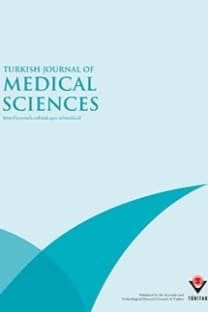Oxygen reserve index guided oxygen titration in one lung ventilation with low fresh gas flow
Oxygen reserve index guided oxygen titration in one lung ventilation with low fresh gas flow
___
- 1. Vos JJ, Willems CH, Van Amsterdam K, Van den Berg JP, Spanjersberg R et al. Oxygen reserve index: validation of a new variable. Anesthesia and Analgesia 2019; 129 (2): 409-415. doi: 10.1213/ANE.0000000000003706
- 2. Lasocki S, Brochant A, Leger M, Gaillard T, Lemarié P et al. ORI monitoring allows a reduction of time with hyperoxia in critically ill patients: the randomized control ORI2 study. Intensive Care Medicine 2019; 45 (11): 1661-1662. doi: 10.1007/s00134-019-05732-9
- 3. Damiani E, Donati A, Girardis M. Oxygen in the critically ill: friend or foe? Current Opinion in Anaesthesiology 2018; 31 (2): 129-135. doi: 10.1097/ACO.0000000000000559
- 4. Helmerhorst HJ, Schultz MJ, Van der Voort PH, De Jonge E, Van Westerloo DJ. Bench-to-bedside review: the effects of hyperoxia during critical illness. Critical Care 2015; 19 (1): 284. doi: 10.1186/s13054-015-0996-4
- 5. Campos JH, Feider A. Hypoxia during one-lung ventilation-a review and update. Journal of Cardiothoracic and Vascular Anesthesia 2018; 32: 2330-2338. doi: 10.1053/j.jvca.2017.12.026
- 6. De la Gala F, Piñeiro P, Reyes A, Vara E, Olmedilla L et al. Postoperative pulmonary complications, pulmonary and systemic inflammatory responses after lung resection surgery with prolonged one-lung ventilation. Randomized controlled trial comparing intravenous and inhalational anaesthesia. British Journal of Anaesthesia 2017; 119 (4): 655-663. doi: 10.1093/bja/aex230
- 7. Karzai W, Schwarzkopf K. Hypoxemia during onelung ventilation: prediction, prevention, and treatment. Anesthesiology 2009; 110 (6): 1402-1411. doi: 10.1097/ALN.0b013e31819fb15d
- 8. Olivant Fisher A, Husain K, Wolfson MR, Hubert TL, Rodriguez E et al. Hyperoxia during one lung ventilation: inflammatory and oxidative responses. Pediatric Pulmonology 2012; 47 (10): 979-986. doi: 10.1002/ppul.22517
- 9. Alday E, Nieves JM, Planas A. Oxygen reserve index predicts hypoxemia during onelung ventilation: an observational diagnostic study. Journal of Cardiothoracic and Vascular Anesthesia 2020; 34 (2): 417-422. doi: 10.1053/j.jvca.2019.06.035
- 10. Campos JH, Sharma A. Predictors of hypoxemia during onelung ventilation in thoracic surgery: is oxygen reserve index (ORI) the answer? Journal of Cardiothoracic and Vascular Anesthesia 2020; 34 (2): 423-425. doi: 10.1053/j.jvca.2019.06.035
- 11. Koishi W, Kumagai M, Ogawa S, Hongo S, Suzuki K. Monitoring the oxygen reserve index can contribute to the early detection of deterioration in blood oxygenation during one-lung ventilation. Minerva Anestesiologica 2018; 84 (9): 1063-1069. doi: 10.23736/S0375-9393.18.12622-8
- 12. Applegate RL 2nd, Dorotta IL, Wells B, Juma D, Applegate PM. The relationship between oxygen reserve index and arterial partial pressure of oxygen during surgery. Anesthesia and Analgesia 2016; 123 (3): 626-633. doi: 10.1213/ANE.0000000000001262
- 13. Blank RS, Colquhoun DA, Durieux ME, Kozower BD, McMurry TL et al. Management of one-lung ventilation: impact of tidal volume on complications after thoracic surgery. Anesthesiology 2016; 124 (6): 1286-1295. doi: 10.1097/ALN.0000000000001100
- ISSN: 1300-0144
- Yayın Aralığı: 6
- Yayıncı: TÜBİTAK
Interleukin-21: a potential biomarker for diagnosis and predicting prognosis in COVID-19 patients
Aslı GÖREK DİLEKTAŞLI, Ezgi DEMİRDÖĞEN, Mehmet KARADAĞ, Ayşe Esra UZASLAN, Ahmet URSAVAŞ, Dane EDİGER, Haluk Barbaros ORAL, Nilüfer Aylin ACET ÖZTÜRK, Necmiye Funda COŞKUN, Diğdem YÖYEN ERMİŞ, Mert KARACA, Shahriyar MAHARRAMOV, Gamze YAZICI
History repeats itself: horse originated hyperimmune sera production against SARS CoV-2
Özcan YILDIRIM, Himmet EKİCİ, Cevdet YARALI, Ufuk ÜLKER, Meral SARPER, Özlem KARDOĞAN, Ümmü Sena SARI, Şahin ÇAKIR, Elvin ÇALIŞKAN, Dilek DÜLGER, Özden KABAKLI, Yasemin SEZGİN, Sabri HACIOĞLU, Erdem DANYER, Züleyha ERGÜN KURT, Hakan TAŞKAYA, Bora ÜNDAR, Gencay ERGİN, Erkan TAÇBAŞ, Ramazan BÜLBÜL, Mu
Şenay ARIKAN DURMAZ, Tülay MORTAŞ, Şaban Cem SEZEN, Yasemin SAVRANLAR
COVID-19 third wave: a challenge for overburdened and underdeveloped healthcare system of Pakistan
Muhammad Ali SYED, Mohammad EJAZ
Kadir Uğur MERT, Göknur YORULMAZ, Selda MURAT, Muhammet DURAL, Elif Sevil ALAGÜNEY, Ahmet Serdar YILMAZ, Nur KEBAPÇI, Ezgi CAMLI, Belgin EFE, Aysen AKALIN, Ahmet Toygar KALKAN
A novel marker of systemic inflammation in psoriasis and related comorbidities: chitotriosidase
Eser Yıldırım SÖZMEN, Bilal İLANBEY, Abdullah DEMİRBAŞ, Mustafa ATASOY, Ümran GÜNAY, Ümit TÜRSEN, Torello LOTTİ, Ömer Faruk ELMAS
Effect of coronavirus pandemic on organ donation and transplantation in Turkey
Mutlu UYSAL YAZICI, Emine Gülşah TORUN
Zühre KAYA, Ülker KOÇAK, Şebnem SOYSAL, Elif KELEŞ GÜLNERMAN, Yağmur ÇAM, İdil YENİCESU, Bülent ELBASAN
Aynur DAĞLAR ADAY, Meliha NALÇACI, Ege Sinan TORUN
High mobility group box- 1 levels may be associated with disease activity of Behcet’s disease
Tahsin Murat TURGAY, Müçteba Enes YAYLA, Murat TORGUTALP, İlyas Ercan OKATAN, Gülay KINIKLI, Didem ŞAHİN EROĞLU, Serdar SEZER, Ayşe Bahar KELEŞOĞLU DİNÇER, Emine Gözde AYDEMİR GÜLÖKSÜZ, Mehmet Levent YÜKSEL, Aşkın ATEŞ, Dilara DÖNMEZ GÜLER, Hasan Selim GÜLER, Zeynep Ceren KARAHAN
